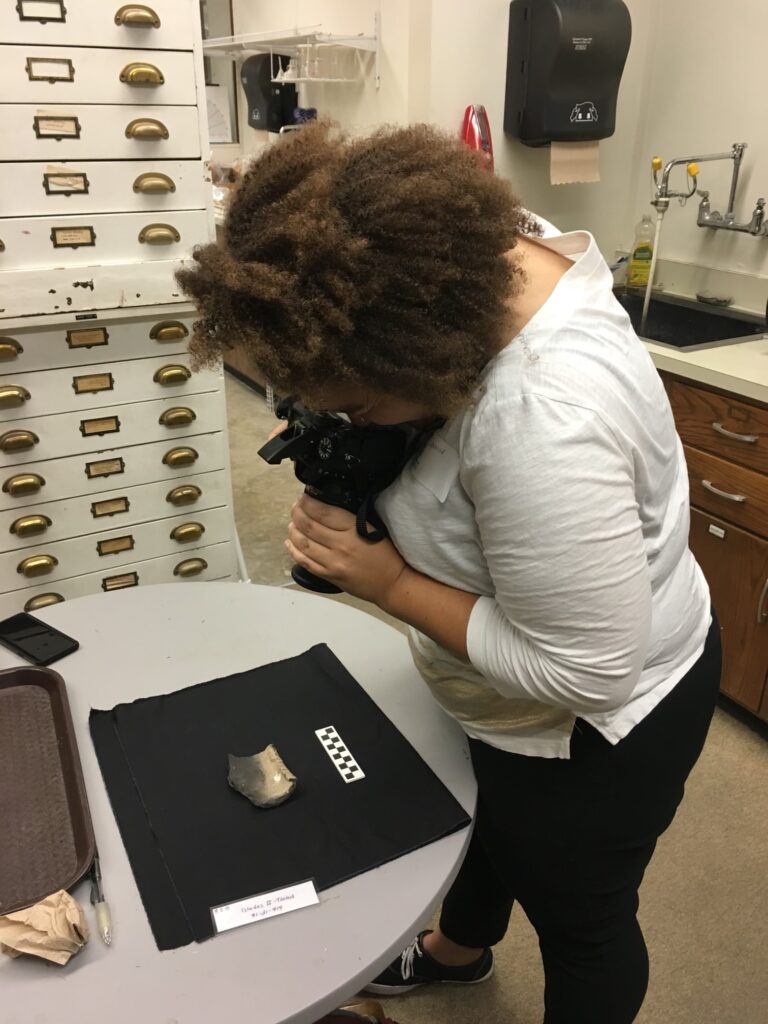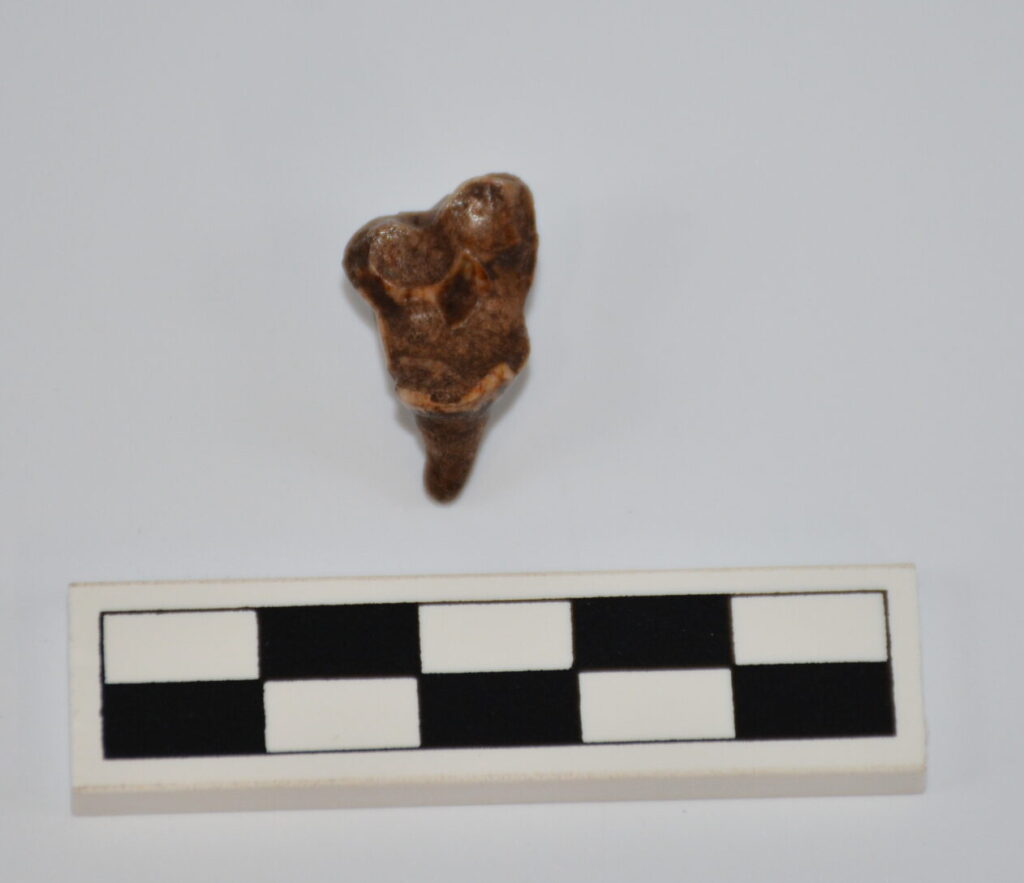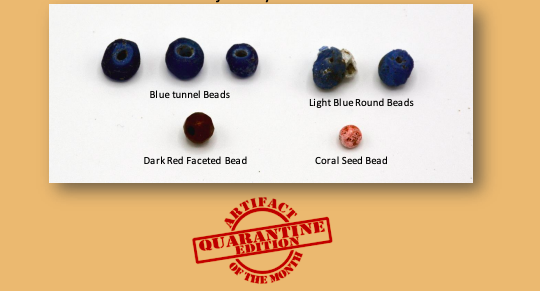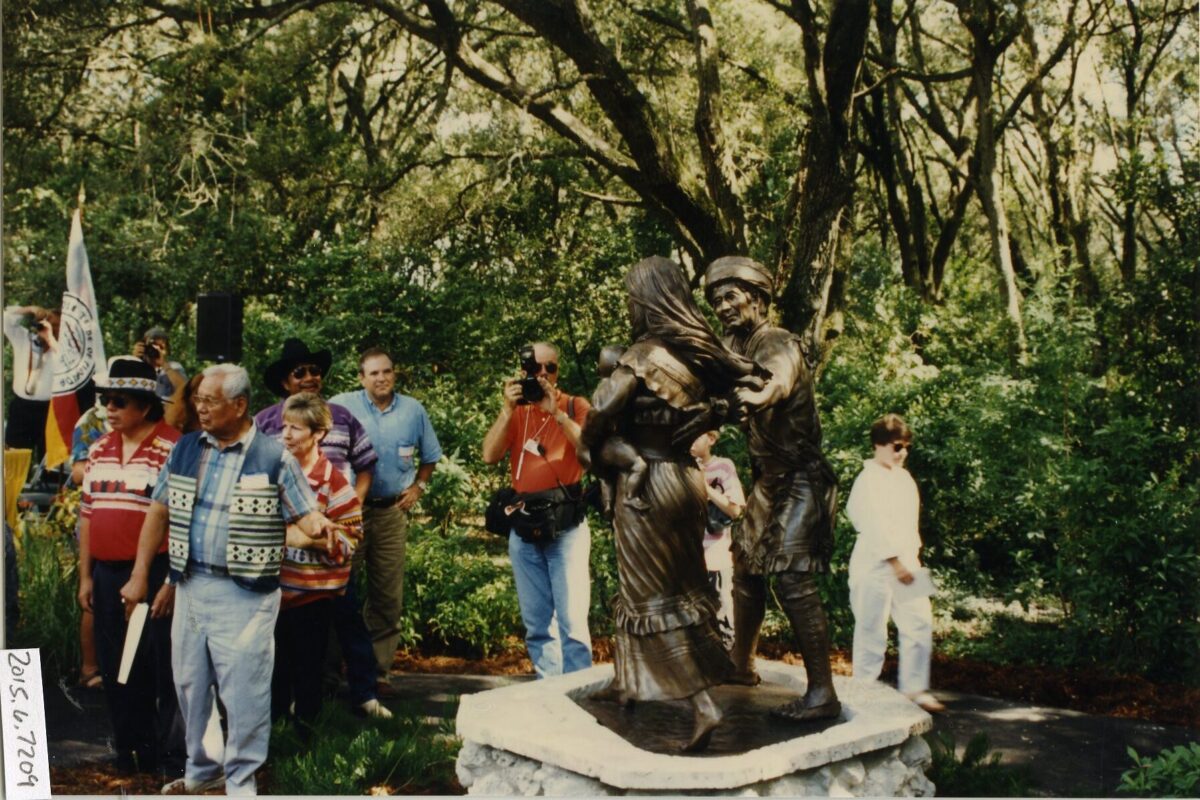
THPO Spotlight: Artifact of the Month
Everyone loves a collaboration! This week, join us as we talk with Samantha Wade, Senior Bioarchaeologist and Lab Supervisor for the Seminole Tribe of Florida Tribal Historic Preservation Office (STOF THPO). Specifically, we will be doing a deep dive into the long-running Artifact of the Month program. The AOM program highlights special artifacts from the THPO’s collection of over 550,000 objects. Through the program, people can learn more about the THPO, as well as Seminole history and archaeology.
In our featured image this week, you can see Samantha Wade, left, and Domonique deBeaubien, right, Collections Manager, during field work in New Smyrna.
Below, you can see an image of Samantha Wade taking a photograph of a pottery piece in 2018. Wade was photographing the pottery piece from the UF Collection in order to build a comparative image resource for pottery identification. Having reference images like this, whether they are pottery, faunal material, or glass is incredibly useful for identifying objects that come in from field work.

Samantha Wade, who spoke with us this week about THPO Collections and the Artifact of the Month Program, is the Senior Bioarchaeologist and Lab Supervisor. After growing up on Long Island, Wade earned her BA in Anthropology from SUNY Oneonta. She moved to Florida in 2011 and received her MS in Forensic Studies with a concentration in Human Identity and Trauma Analysis from Florida Gulf Coast University. Wade has been with the THPO as their Bioarchaeologist since 2017. She became Senior Bioarchaeologist in January 2022, and Lab Supervisor in 2023.
What does THPO Collections do?
The Collections Section of the THPO has three main parts: the archaeological lab, research, and NAGPRA. The lab processes and accessions any and all artifacts that come through. They also maintain an inventory of the collection, and take care of the items within the collection. The research arm of the Collections team “performs the historic and academic research needed to best support and accurately tell the story of the Seminole Tribe of Florida and their ancestors.” This includes outreach within the community, working with both academics and the public, and furthering the decolonization of history.
This arm of the Collections section also works on maintaining the Seminole Site File, a repository for the Tribe’s cultural resource information. This includes archaeological sites, traditional cultural properties, and historic buildings and structures. Part of this also includes the Tribal Register of Historic Places (TRHP), the top tier of the Site file which works to preserve and protect exceptionally significant sites. Some examples of places on the TRHP we have discussed in the past are Red Barn, Sam Jones Trail, and the Council Oak.
The final facet of the Collections section works on the Native American Graves Protection and Repatriation Act (NAGPRA) committee. NAGPRA is a federal law, passed in 1990, that “[provides] a process for museums and federal agencies to return certain Native American cultural items — human remains, funerary objects, sacred objects, or objects of cultural patrimony — to lineal descendants, and culturally affiliated Indian tribes and Native Hawaiian organizations.” The Seminole Tribe of Florida and the THPO are committed to making ancestor repatriation a priority. Recently, the THPO launched the #NoMoreStolenAncestors campaign, which urges the return of 1,496 ancestral remains from the Smithsonian Institution’s National Museum of Natural History (NMNH). We encourage you to learn more about this campaign, and the important repatriation work that is being done throughout Indian Country.
The STOF-THPO Archaeological Collection
Did you know that the THPO cares for an entire archaeological collection, separate from the Ah-Tah-Thi-Ki Museum? Consisting of over 550,000 unique objects, the THPO’s archaeological collection predominantly comes from field work. The THPO’s Tribal Archaeology Section (TAS) often collects artifacts from the field as part of their Phase I and Phase II surveys. Phase I surveys include excavating small holes (shovel tests) in uniform intervals, to determine if there is an archeological site. Often, TAS completes these surveys to clear land for construction projects, cattle grazing, or other land-use projects. Phase II surveys are more in-depth, and include digging metered units to further investigate known sites. Artifacts can range from faunal material (animal bones), pottery, glass, metal scraps, ceramics, projectile points, beads, and any other associated items. Any artifacts that are collected come back to the Lab. Then, the Collections team accessions them into the THPO Archaeological Collection!

Once the artifacts come back, they go to the lab for processing. This begins by something deceptively simple; washing! Often, items that come back from field work are incredibly dirty, so the Collections team begins by washing each and every artifact that comes into the lab. Simple deionized water and a soft toothbrush is often enough for most objects. Then, Collections will sort and identify them. This means figuring out, to the best of their ability, what each item is. For example, if you have a piece of turtle shell, can you identify what kind of turtle it is from? During this process, Collections counts, weighs, and assigns a catalog number. Finally, Collections bags and tags each item, placing them in archival quality materials to ensure long-term care. Certain items like bottles, projectile points, and oversized artifacts require the Collections team to craft custom housing.
The Artifact of the Month Program, and why is it important?
The Artifact of the Month Program began in 2014. Once a month, the Collections team picks a single artifact to highlight and do further research. Then, Collections shares the artifact and accompanying research with the wider community. Basically, it is a little peek into the collection, allowing people to become more familiar with the objects THPO Collections cares for. The Artifact of the Month program may seem like a fun, innocuous monthly newsletter. But, it serves a special function. The AOM program “is important” Wade says, “because it allows for over 550,000 objects to get more exposure, what they are, where they come from, why they’re important. Not only to us in Collections, but also to the Seminole Tribe of Florida.” Making connections that cement these physical objects with Seminole history goes a long way to educating people about Seminole story, culture, and perspective.
The importance is also two-fold for the Collections team. Being able to dive deep into the research for a particular item is a luxury. But, the AOM program, Wade states, “allows for time to research something further. For the most part unless it’s something diagnostic, we aren’t really diving much more into it.” The Artifact of the Month program allows individuals in the Collections team to highlight things they are really interested in. Wade particularly likes that facet of the program. She says it gives them the freedom to say “this is what is interesting about this thing, and what is fascinating. I liked that.”
Favorite Artifacts of the Month
While chatting, Sam was able to share two previous artifacts of the month that stuck with her. The first, a Ross’s Belfast Dry Ginger Ale bottle, can be seen below. Collections featured this artifact in the November 2022 AOM. The Tribal Archaeology Section found the bottle on the Big Cypress Reservation. The Ross Company, which was located in Belfast, Ireland, began manufacturing ginger ale in 1879. Their product became incredibly popular due to the quality of their ingredients, which included “Jamaican ginger, sugar cane from the West Indies, and the famous aerated waters found in the city of Belfast.”
Ross’s Ginger Ale was predominantly manufactured for sale overseas, and almost one million bottles were imported into New York State in 1883. That is a lot of ginger ale! What makes this bottle particularly unique is the torpedo-shape, which “has a rounded bottom, forcing the bottle to be laid on its side for transportation and storage.”

The second significant artifact that Wade shared was the possible Coyote/Dog Tooth featured in September 2022’s AOM. This one was a bit of a mystery for the Collections team! Discovered in 2020 by TAS, when this tooth made it to the lab they realized that they were having a hard time identifying it. The size and shape of the tooth “sits in between two species, dog and coyote.” They knew that it was too small for a wolf, but due to the size and shape couldn’t accurately say it was a dog either. Was this tooth from a transitional animal between wild coyote and domesticated dog?
Ultimately, THPO Collections sent the tooth out for carbon-dating. This testing was to help determine how old it was and help with the identification. Wade emphasized that this is one of her favorite featured AOMs because the artifact no longer exists, as it was destroyed in the testing process. So, for this tooth, Wade notes the “only photos we have are the ones taken for Artifact of the Month.”

Goals for the Collections Section…
During our discussion, Wade emphasized several goals for the Collections section in the upcoming months. Her number one goal is to educate. She explains that “a lot of what we do gets lost in paper shuffle, and no one but us sees it. So, having this exposure allows us to bring attention to an actual thing like Payne’s Prairie, instead of it being just a folder on our desk.” Programs like Artifact of the Month are ideal for sharing the Seminole story. They feature tangible items the Collections team can use to highlight specific people, trends, places, and historic moments.
Artifacts from places like Fort Shackleford, located on the Big Cypress Reservation, help spur discussions about the Seminole War. Other items, like the beads featured in a 2020 Artifact of the Month: Quarantine Edition, below, bring up conversations about trade, movement of people and goods, and Seminole history. Wade explains that they are looking to put out more meaningful social media content. She says they’re trying “to help build more connections and educate on a higher level.” For the THPO, social media is currently a fledgling space for them, one they want to utilize further to educate people.

…And the THPO!
Wade’s second goal moving forward is to make their work and staff to be more visible online. Recently, the THPO launched a brand-new website aimed at fulfilling this goal. Sam, who oversaw the website redesign, notes that she still has things she wants to improve. “I want the website to be more fluid, more integrated and dynamic,” She laughed as we chatted “less flat.” Additionally, they are looking to feature more projects that are being put out, by all the THPO staff. Specifically, Wade says, “We are looking for cohesive effort from all sections, each section and people to be more engaged with putting up their own projects.” One example is the recent Big Cypress Historic Trails Story Map. The Story map was a collaborative project with Archaeometry (Matthew Reyes, J. Nicholas Butler), Collections (Dave Scheidecker), and THPO Management (Juan Cancel).
Transparency and highlighting the staff, so people can put a name to their faces, are equally important moving forward. Now, you can learn more about some of the THPO Staff through their social media. Even their favorite ice cream flavors!
So, what do you think? We encourage you to explore past Artifacts of the Month and comment below or on our social media! What is your favorite? Which objects would you like to learn more about?
Author Bio
Originally from Washington state, Deanna Butler received her BA in Archaeological Sciences from the University of Washington in 2014. Deanna moved to South Florida in 2016. Soon, she began working for the Seminole Tribe of Florida’s Tribal Historic Preservation Office. Deanna was the THPO’s Archaeological Collections Assistant from 2017-2021. While at the THPO, Deanna worked to preserve, support, and process the Tribe’s archaeological collection. She often wrote the popular Artifact of the Month series, and worked on many community and educational outreach programs. She lives in Fort Myers, FL with her husband, son, and dog.



